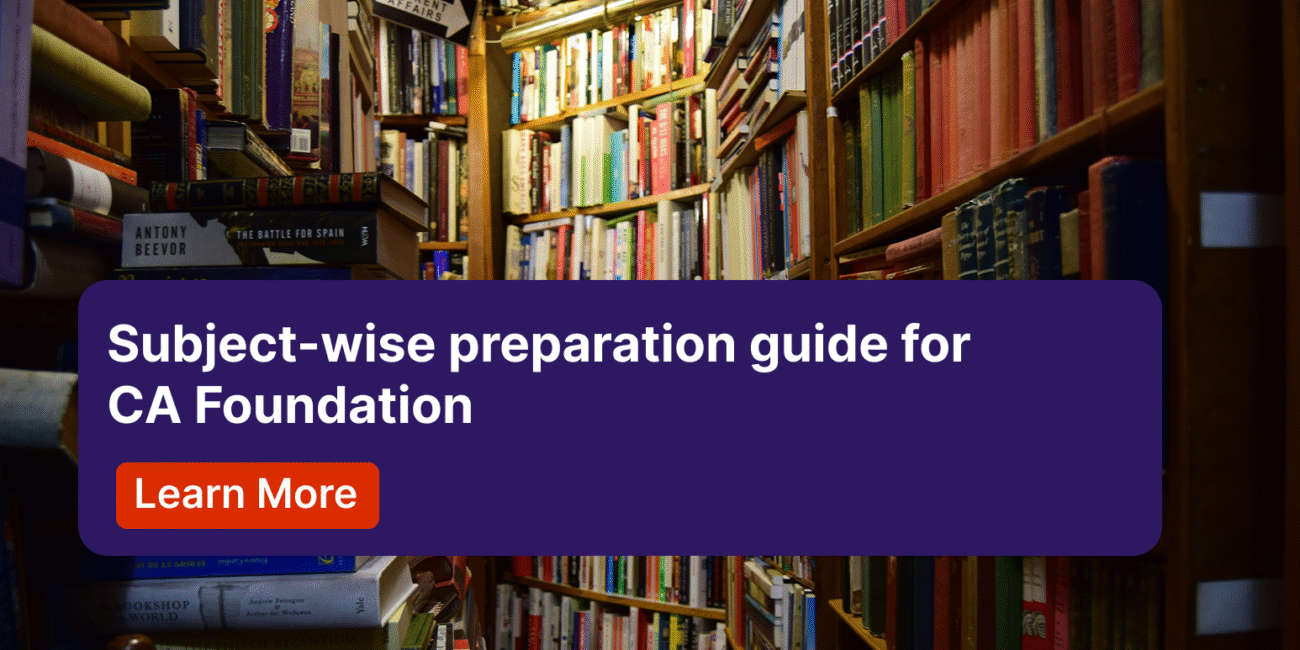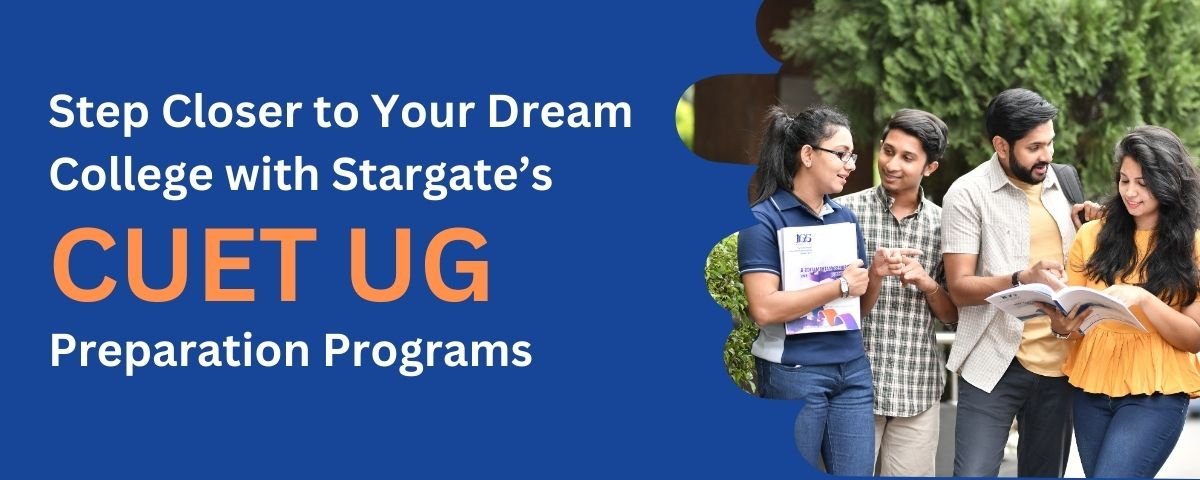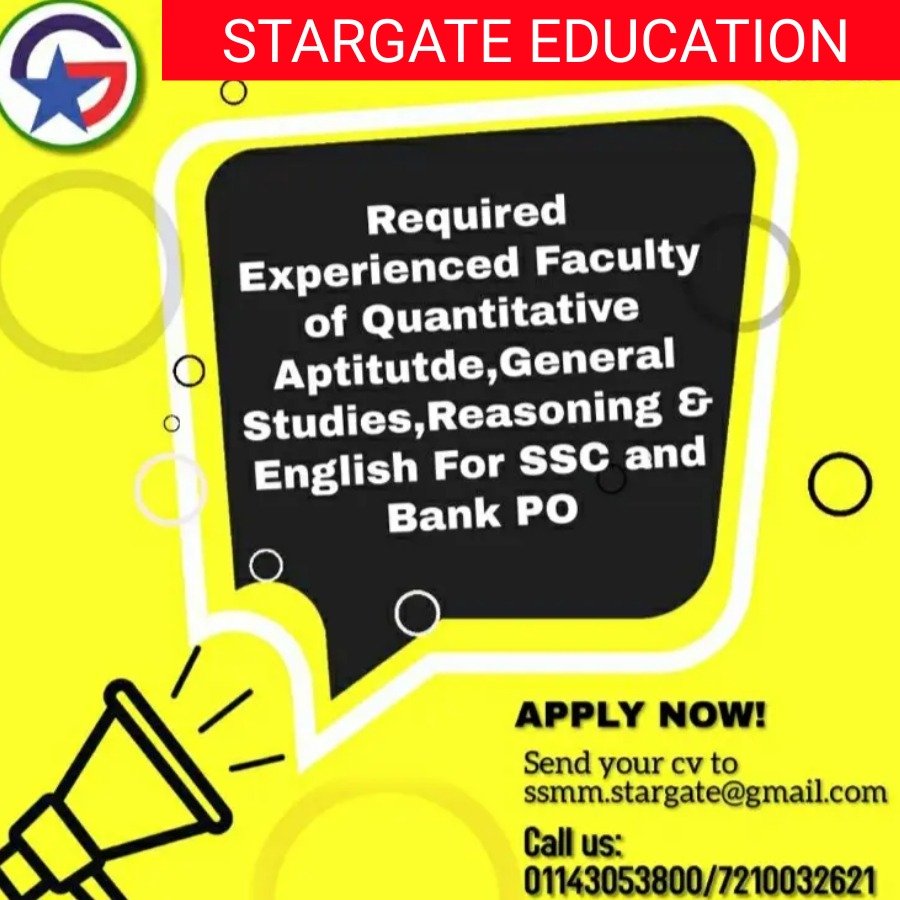
Subject-wise preparation guide for CA Foundation
The CA Foundation examination, conducted by the Institute of Chartered Accountants of India (ICAI), is the first step on the path to becoming a chartered accountant. It tests foundational knowledge across four papers: Accounting; Business Laws & Correspondence; Quantitative Aptitude (Mathematics & Statistics); and Business Economics & Commercial Knowledge.
Each subject demands a different approach—while some are calculation-heavy (Accounting, Maths), others are concept and memory-driven (Business Laws, Economics). A subject-wise guide will help you allocate your time and effort well, play to your strengths, and shore up your weaknesses. As one article puts it: “success at this level isn’t just about studying hard; it’s about studying smart.”
In what follows, we’ll walk through each paper in turn, offering:
- An overview of what the paper covers
- Key strategies & how to approach it
- Time-management, revision and practice tips
- Common pitfalls and how to avoid them
Let’s begin.
Paper 1: Principles & Practice of Accounting
1. What the paper covers
Paper 1 of the CA Foundation covers the fundamental accounting concepts, processes and applications. According to the syllabus, it includes topics such as theoretical framework, accounting process, trial balance, rectification of errors, bank reconciliation statements, inventories, depreciation, bills of exchange, final accounts of sole proprietors, not-for-profit organisations, incomplete records, partnership accounts, LLPs, company accounts and so on.
2. Why this subject is important
Accounting forms the backbone of the CA qualification. A strong command here not only helps you clear the Foundation level, but also sets you up for Intermediate and Final levels. Moreover, many students find this a “scoring” subject if you practise well, because you can predict formats, apply rules and avoid surprises. For example, one guide states: “Instead of blindly memorising journal formats, aim to grasp the ‘why’ behind every debit and credit.”
3. Preparation strategy
a) Build conceptual clarity
Begin with the theoretical framework: understand accounting concepts, conventions, the accounting equation, measurement principles. Make sure you know why things are done a certain way.
- Use ICAI’s official modules/study material as your base.
- Make your own short notes for definitions, conventions, formats.
b) Work through the process and numerical questions
After the basics, move to the accounting process: journal entries, ledger posting, trial balance, rectification of errors, bank reconciliation statements (BRS), inventories, depreciation. These are heavy on applied work. Allocate significant practice time to them.
c) Cover special transactions & advanced topics
Once your basics are strong, cover items like bills of exchange, consignment (if included), incomplete records, partnership, LLP, company accounts. These tend to consume time, so aim to practise them thoroughly.
d) Practice with past papers and time yourself
- Use past year questions and revision test papers (RTPs)/mock test papers (MTPs) released by ICAI.
- Simulate exam conditions: 3 hours (for subjective paper) with full attempt.
e) Revision & formula sheet
- Maintain a formula sheet for depreciation, inventory valuation, partnership adjustments, company accounts.
- Periodically revise formats (e.g., final accounts of sole proprietors, partnership accounts) since format mistakes cost marks.
- One author suggests: “Prepare a quick revision sheet with important formats and formulas.”
4. Time-management & practice recommendations
- Allocate around 30-35% of your total study time to Accounting (since it is heavy).
- Early on, spend more on building conceptual clarity and small applied questions; later, shift to full length practice and error correction.
- In each study session, take one live question or past problem, solve it, mark errors, review your method.
5. Common pitfalls & how to avoid them
- Pitfall: Memorising journal/ledger formats without understanding the logic → leads to mistakes when adjustments are involved.
Avoidance: Always ask “why” a particular entry is made. - Pitfall: Neglecting small but tricky topics like BRS, incomplete records → these often surprise candidates.
Avoidance: Give dedicated time to these “niche” but important topics early. - Pitfall: Poor presentation of accounts/format in exam → even correct entries may lose marks.
Avoidance: Practise writing complete formats; use correct headings; learn presentation style. - Pitfall: Not revising regularly → Concepts fade over time.
Avoidance: Have a rolling revision schedule (weekly or bi-weekly) for earlier-studied topics.
6. How to maximise score
- Start with higher-weightage areas: accounting process, final accounts, partnership & company accounts. Weightage analysis shows e.g. 25-30% marks for ‘Accounting Process’ in Paper 1.
- Use error logs: maintain a list of mistakes you repeatedly make (e.g., forgetting to adjust for depreciation, mis-posting a ledger).
- Aim for accuracy rather than speed initially; increase speed only after you’re accurate.
- Leave buffer time in the actual exam to revise the entire answer sheet for silly errors.
Paper 2: Business Laws & Business Correspondence & Reporting
1. What the paper covers
Paper 2 is a dual-section paper under the new scheme:
- Section A: Business Laws (e.g., Indian Contract Act, Sale of Goods Act, LLP Act, Companies Act)
- Section B: Business Correspondence & Reporting (BCR) covering business communication skills – letters, reports, vocabulary, comprehension, note-making.
2. Why this subject is important
Business Laws tests your legal foundation and understanding of business statutes—essential for any CA. BCR tests your communication, which is increasingly important in the profession. While Law may seem heavy on memory, many students fetch solid marks by consistent preparation and good answer-writing. One guide notes: “Write sample answers … learn answer-framing techniques.”
3. Preparation strategy
a) For Business Laws
Start with key acts: Indian Contract Act (ICA), Sale of Goods Act (SGA), Partnership Act, LLP Act, Companies Act. Note from weightage analysis: ICA may carry ~15-20% or more.
Understand the provision, meaning, elements, case-application. One Reddit commentary emphasises answer format: provision → analysis → conclusion.
Make concise notes of sections, definitions, case law, key amendments.
Do write practice: answer-writing helps consolidate.
b) For Business Correspondence & Reporting
Master active & passive voice, synonyms, comprehension, writing business letters & reports.
Practice MCQs and short-answer type questions in BCR portion.
Work on presentation—clear structure, underlined headings, bullet points where needed.
c) Integrate practice & revision
Use the ICAI modules and question banks.
Solve previous year questions (PYQs), attempt mock tests within time.
Regularly revise law provisions and BCR communication skills.
4. Time-management & practice recommendations
- Allocate around 25-30% of your study time to this paper.
- In early phase, focus more on theory (law) and fundamentals (BCR). In later phase, switch to full-length practice and time-bound answer-writing.
- For each law chapter, allocate time to read, summarise, practise a few MCQs and one or two case-based answers.
- For BCR, dedicate short daily slots for vocabulary, comprehension, and one writing exercise.
5. Common pitfalls & how to avoid them
- Pitfall: Relying purely on rote memorisation without understanding application → results in inability to tackle case-based questions.
Avoidance: Understand the rationale behind each provision; practise writing answers. - Pitfall: Poor answer presentation in BCR → despite correct content, marks lost due to structure/presentation.
Avoidance: Practice writing letters/reports; follow sample formats; use clear headings. - Pitfall: Ignoring vocabulary/grammar in BCR → small mistakes cost disproportionate marks.
Avoidance: Daily practice of 15–20 minutes: synonyms, active/passive voice, error spotting. - Pitfall: Not revising law provisions regularly → law chapters forgotten over time.
Avoidance: Use spaced-revision: revisit each law chapter every week or fortnight.
6. How to maximise score
- Identify high-weight chapters (e.g., Contract Act) and ensure mastery.
- Keep a separate notebook of “must-know” case laws and frequently tested sections.
- For BCR, perfect small tasks (e.g., report writing) so they become quick and almost automatic.
- In the exam, aim to allocate time: about 1.5–2 hours for Law, ~1 hour for BCR (depending on total time).
Paper 3: Business Mathematics, Logical Reasoning & Statistics
1. What the paper covers
Paper 3 under the new scheme is objective in nature and covers three parts: Business Mathematics (Part A, 40 marks), Logical Reasoning (Part B, 20 marks), and Statistics (Part C, 40 marks).
Topics include ratios/indices/matrices/equations, time value of money, permutations/combinations; logical reasoning topics such as coding-decoding, seating arrangements, syllogisms; and statistics covering data presentation, central tendency, probability, distributions, correlation/regression, index numbers/time series.
2. Why this subject is important
This paper tests analytical and quantitative aptitude—skills highly valued in the CA profession. Although many find it challenging (especially if coming from non-maths background), with consistent practice it becomes manageable. A Reddit user observes:
“For maths … practice the entire module … and do PYQs … speed matters.”
Scoring well here can boost your overall aggregate, and since it is objective-type, good practice can yield high marks.
3. Preparation strategy
a) Business Mathematics
Begin by mastering basic algebra, ratios, indices, matrices, equations. Then time value of money, permutations/combinations, series.
Make a formula book for quick reference (time value of money, interest, annuities, etc.).
Solve many practice problems—quantity matters.
b) Logical Reasoning
Focus on seating/direction/coding, blood relations, syllogisms. Practice short questions with time constraints.
Learn to identify patterns rather than memorise each question.
c) Statistics
Start with fundamentals: data presentation, central tendency, dispersion. Then move to probability, distributions, correlation/regression, index/time-series.
Create small summary sheets for key formulas (mean, median, variance, probability rules) etc.
d) Mock practice and time management
Since the paper is objective, speed and accuracy are essential. Practice large sets of MCQs under timed conditions.
Keep a habit of solving last 6–8 years’ objective questions to recognise repeated patterns.
e) Revision & shortcuts
Revise formulas and concepts weekly.
For mathematical parts, learn calculation shortcuts (e.g., for time value of money).
Use error logs for topics you keep making mistakes in (e.g., permutations vs combinations confusion, regression formula errors).
4. Time-management & practice recommendations
- Allocate around 20-25% of study time to this paper (given its objective nature but high importance).
- Divide your time daily: e.g., 40 minutes for maths, 20 minutes for LR, 40 minutes for statistics (or according to your strengths/weaknesses).
- In mock test mode, simulate full paper: 100 questions in ~2–3 hours (or the actual exam time as per latest pattern).
- Keep reviewing your speed & accuracy metrics—if you’re spending too long on one question type, adjust practice accordingly.
5. Common pitfalls & how to avoid them
- Pitfall: Poor speed and spending too long on one tough question → risks leaving easier questions unanswered.
Avoidance: Set a timer for each question during practice; skip and mark difficult questions and return later. - Pitfall: Weak fundamentals (especially for students from non-maths background) leading to repeated mistakes.
Avoidance: Revise basics thoroughly; don’t jump to complex questions until fundamentals are rock-solid. - Pitfall: Not practising enough objective/MCQ questions → leads to exam time shock.
Avoidance: Daily MCQ practice, timed sets, and past PYQs. - Pitfall: Not maintaining formula sheets → forgetting key formulas in exam.
Avoidance: Keep one concise sheet; revise at least weekly.
6. How to maximise score
- Identify and prioritise topics with higher weightage (e.g., time value of money, data presentation may carry higher marks).
- Aim for near zero errors in MCQs by practicing error-tracking: note down mistake reasons (e.g., “mis-applied formula”, “calculation error”, “mis‐read question”).
- Use elimination tactics in MCQs (if unsure, eliminate obviously wrong options first).
- In the actual exam, attempt easier sections first (maybe LR + part of maths) then move to heavier statistics portion to manage time and confidence.
Paper 4: Business Economics & Business & Commercial Knowledge
1. What the paper covers
Paper 4 is also objective type and covers two broad sections: Section A – Business Economics (micro/macro, demand & supply, production/cost theory, price determination, national income etc.), and Section B – Business & Commercial Knowledge (business environment, business organisations, government policies, business terminologies etc.).
2. Why this subject is important
This paper offers a mix of conceptual economics and general business awareness. For many aspirants, this subject becomes a “puller” if prepared well—since business environment questions can be relatively straightforward. However, lack of preparation or ignoring it can lead to surprises. A reddit post notes:
“Economics … many PPL pass because of this subject … but don’t ignore it also.”
3. Preparation strategy
a) Business Economics
- Start with microeconomic topics: demand & supply theory, elasticity, production & cost theory, market structures.
- Then macro: national income, business cycles, economic growth & development, inflation, government policy.
- Use diagrams (demand/supply curves) extensively—economics often carries diagrams and you should be comfortable drawing and interpreting them.
- Maintain a list of key economic definitions, formulas (e.g., GDP, GNP, cost functions) and diagrams.
b) Business & Commercial Knowledge
- Focus on business environment, forms of organisations, government initiatives, trade policies, e-commerce, corporate governance.
- Stay updated: though the Foundation exam focuses more on core knowledge than current affairs, recent developments may appear—so maintain a short “recent business news” sheet.
- Practice MCQs heavily—this section is objective and speed/memory matter.
c) Integration & revision
- Use summary notes: economics theory + diagrams + business knowledge must be revised frequently.
- Use official ICAI study modules and revision materials.
- Solve past objective questions, and keep short weekly mini-tests to maintain momentum.
4. Time-management & practice recommendations
- Allocate around 20-25% of your study time to this paper (given it’s objective but covers a wide topic range).
- Daily schedule: e.g., 30 minutes of economics theory/diagram, 30 minutes of business & commercial knowledge MCQs.
- Weekly full-length objective test for Paper 4: perhaps 100 MCQs in ~2 hours. Review and log mistakes.
5. Common pitfalls & how to avoid them
- Pitfall: Ignoring diagrams in economics or being weak at drawing/understanding them → results in loss of marks.
Avoidance: Practice drawing key diagrams (e.g., cost curves, demand/supply shifts) and write short notes explaining them. - Pitfall: Treating business & commercial knowledge as “easy so minimal effort” → leads to easy marks lost.
Avoidance: Give dedicated time to this section; practise MCQs daily and maintain current-awareness sheet. - Pitfall: Not revising old topics → concepts fade.
Avoidance: Use spaced-revision—economics especially benefits from this because of theory + diagrams. - Pitfall: Poor speed in objective questions → leaving many questions unanswered.
Avoidance: Timed MCQ sets, eliminate wrong options quickly, improve mental math/reading speed.
6. How to maximise score
- Focus on high-weightage chapters (e.g., demand & supply, national income). According to weightage analysis, some micro topics carry higher marks.
- Use diagrams whenever possible—these are often easy marks if drawn and labelled correctly.
- Keep a “business flashcard” list of key terms/initiatives/policies and revise daily.
- In the exam, begin with easier MCQs you are confident about to build momentum, then move to slightly tougher ones. Ensure you attempt all questions (since objective).
Revision, Mock Tests & Overall Strategy
1. Revision strategy
- After finishing each subject’s first pass, schedule periodic revisions. Use short notes, formula sheets, flashcards and mind maps.
- Use the “spacing effect”: revise after 1 day, 1 week, 1 month for each topic so that retention improves.
- For Accounting and Law, practise one revision problem/answer per day. For Maths/Statistics/Economics, practise one timed set of questions.
2. Mock tests & past papers
- Regularly attempt full-length mock exams under exam conditions. This helps improve stamina, time management and reveals weak areas. One guide says: “Mock tests are essential for identifying weaknesses and getting accustomed to the exam format.”
- Analyse each mock test: note down errors (conceptual, careless, time pressure), and build an “error log”. Then prioritise those topics in the next week’s practice.
3. Weekday vs weekend planning
- Use weekdays for new content and practice in smaller chunks (2-3 hours). Use weekends for longer sessions — deep practice, full mock tests, revision. This ensures you use calendar time wisely.
- As exam date nears (last 4-6 weeks), increase frequency of full mocks (e.g., one every weekend), revise weak areas, limit new topics.
4. Time-table & subject allocation
- Create a balanced timetable: allocate more time to weaker subjects, but don’t neglect your strengths.
- Example: If Accounting and Maths are your strong areas, still allocate them time each week (for practice) but give extra slots to e.g., Business Laws or Business & Commercial Knowledge if you feel weaker there.
- Ensure you have built-in “buffer slots” for revision, false starts, or unexpected study blocks.
5. Health, mindset & consistency
- Maintain consistent study hours daily; avoid long gaps.
- Keep healthy sleep, diet and short breaks — burnout impacts retention and performance.
- Stay motivated: remind yourself of your end-goal (becoming a Chartered Accountant) and celebrate small wins (completing a chapter, scoring well in a mock test).
- Keep a positive attitude — many aspirants clear the Foundation by disciplined, smart preparation rather than just raw hours.
Summary & Final Words
Preparing for the CA Foundation exam is a demanding but entirely achievable goal if you adopt a subject-wise, structured approach. By breaking down each paper—Accounting, Business Laws & BCR, Maths/Logical Reasoning/Statistics, and Business Economics & Commercial Knowledge—you can plan your preparation effectively.
Here’s a recap of the key takeaways:
- Use the best resources (especially official ICAI study modules and latest revision materials).
- For Accounting and Maths/Statistics: practice relentlessly, build conceptual clarity, work on speed and accuracy.
- For Business Laws & BCR and Economics & Commercial Knowledge: understand concepts, maintain note-books/flashcards, practise answer-writing/MCQs and stay updated.
- Regular revision & mock tests are critical — they help you avoid surprises in the actual exam.
- Manage your time, keep a balanced timetable, look after your physical and mental health, and stay consistent.
At the end of the day, many aspirants succeed not because they found miraculous shortcuts, but because they stuck to a well-designed plan, revised smartly, practised thoroughly and remained disciplined. As one guide states: “Prepare smartly, not just harder.”
Connect With Us
If you’re serious about CUET 2026 and want expert guidance to get into your dream college, reach out to Stargate Education. Call us at 7210032621 and our team will help you with all the details, demo sessions, and batch timings.
We’re here to guide you every step of the way!
Start Your Journey to CUET UG Success Today!
Register now and gain exclusive access to invaluable resources designed to enhance your CUET UG preparation journey.








